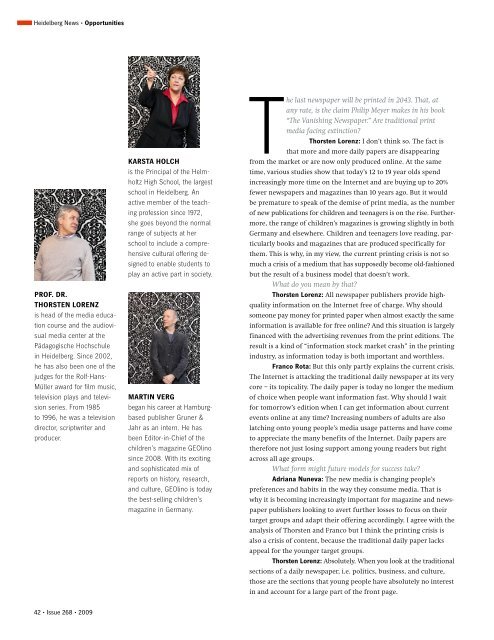A hArd-hitting - Plantin
A hArd-hitting - Plantin
A hArd-hitting - Plantin
Create successful ePaper yourself
Turn your PDF publications into a flip-book with our unique Google optimized e-Paper software.
Heidelberg News • opportunities<br />
PRoF. DR.<br />
THoRSTEN LoRENz<br />
is head of the media education<br />
course and the audiovisual<br />
media center at the<br />
Pädagogische Hochschule<br />
in Heidelberg. since 2002,<br />
he has also been one of the<br />
judges for the rolf-Hans-<br />
Müller award for film music,<br />
television plays and television<br />
series. from 1985<br />
to 1996, he was a television<br />
director, scriptwriter and<br />
producer.<br />
42 • Issue 268 • 2009<br />
KARSTA HoLCH<br />
is the Principal of the Helmholtz<br />
High school, the largest<br />
school in Heidelberg. an<br />
active member of the teaching<br />
profession since 1972,<br />
she goes beyond the normal<br />
range of subjects at her<br />
school to include a comprehensive<br />
cultural offering designed<br />
to enable students to<br />
play an active part in society.<br />
MARTIN VERG<br />
began his career at Hamburgbased<br />
publisher Gruner &<br />
Jahr as an intern. He has<br />
been editor-in-Chief of the<br />
children’s magazine Geolino<br />
since 2008. With its exciting<br />
and sophisticated mix of<br />
reports on history, research,<br />
and culture, Geolino is today<br />
the best-selling children’s<br />
magazine in Germany.<br />
the last newspaper will be printed in 2043. That, at<br />
any rate, is the claim Philip Meyer makes in his book<br />
“The Vanishing Newspaper.” Are traditional print<br />
media facing extinction?<br />
Thorsten Lorenz: I don’t think so. The fact is<br />
that more and more daily papers are disappearing<br />
from the market or are now only produced online. At the same<br />
time, various studies show that today’s 12 to 19 year olds spend<br />
increasingly more time on the Internet and are buying up to 20%<br />
fewer newspapers and magazines than 10 years ago. But it would<br />
be premature to speak of the demise of print media, as the number<br />
of new publications for children and teenagers is on the rise. Furthermore,<br />
the range of children’s magazines is growing slightly in both<br />
Germany and elsewhere. Children and teenagers love reading, particularly<br />
books and magazines that are produced specifically for<br />
them. This is why, in my view, the current printing crisis is not so<br />
much a crisis of a medium that has supposedly become old-fashioned<br />
but the result of a business model that doesn’t work.<br />
What do you mean by that?<br />
Thorsten Lorenz: All newspaper publishers provide highquality<br />
information on the Internet free of charge. Why should<br />
someone pay money for printed paper when almost exactly the same<br />
information is available for free online? And this situation is largely<br />
financed with the advertising revenues from the print editions. The<br />
result is a kind of “information stock market crash” in the printing<br />
industry, as information today is both important and worthless.<br />
Franco Rota: But this only partly explains the current crisis.<br />
The Internet is attacking the traditional daily newspaper at its very<br />
core – its topicality. The daily paper is today no longer the medium<br />
of choice when people want information fast. Why should I wait<br />
for tomorrow’s edition when I can get information about current<br />
events online at any time? Increasing numbers of adults are also<br />
latching onto young people’s media usage patterns and have come<br />
to appreciate the many benefits of the Internet. Daily papers are<br />
therefore not just losing support among young readers but right<br />
across all age groups.<br />
What form might future models for success take?<br />
Adriana Nuneva: The new media is changing people’s<br />
preferences and habits in the way they consume media. That is<br />
why it is becoming increasingly important for magazine and newspaper<br />
publishers looking to avert further losses to focus on their<br />
target groups and adapt their offering accordingly. I agree with the<br />
analysis of Thorsten and Franco but I think the printing crisis is<br />
also a crisis of content, because the traditional daily paper lacks<br />
appeal for the younger target groups.<br />
Thorsten Lorenz: Absolutely. When you look at the traditional<br />
sections of a daily newspaper, i.e. politics, business, and culture,<br />
those are the sections that young people have absolutely no interest<br />
in and account for a large part of the front page.





